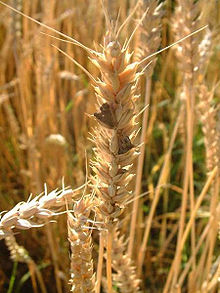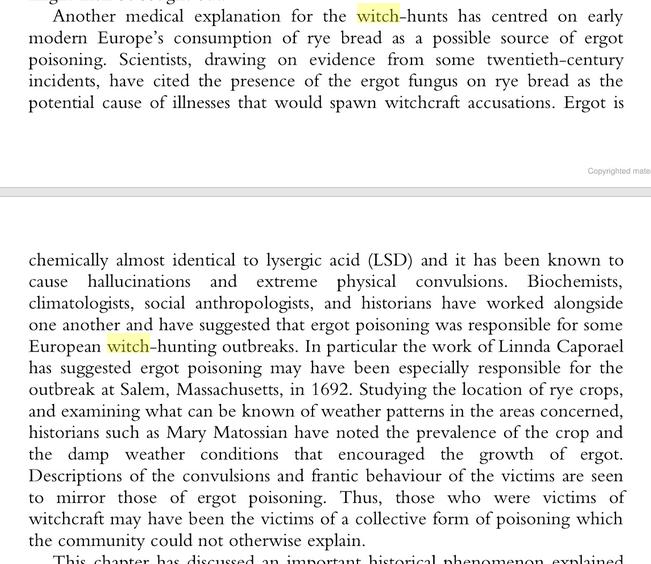Ergot Madness in Historians March 7, 2016
Author: Beach Combing | in : Ancient, Contemporary, Medieval, Modern , trackback
Ergot is a fungus that grows on some crops, particularly rye, and is most common in northern temporal climes. When ingested by humans or animals it can cause hallucinations, temporary neurological disorders and circulation difficulties including burning limbs and, in serious cases, gangrene: there are records of peasants who lost all four limbs to ergot poisoning (St Anthony’s Fire). Ergot was not ‘scientifically’ connected with these symptoms until the late seventeenth century: though there are ancient records that suggest a connection may have been made before, not least in the ancient world. However, historians long since realized that ergot offers them a glorious joker in the pack. If something strange happens in history then the historian lifts his eyebrows knowingly and says: ‘Ergot poisoning!’ And, Bob’s your uncle, ‘strange thing in history’ has been billeted in the hotel of the explained rather than the youth hostel of loose ends. Beach has been amused over the years at just how many things historians have attempted or suggested might be explained in this way. Here is a list. Note that this list does not, of course, represent ergot poisoning. What it really represents are events in the past that are absolutely impenetrable to the modern historical mind.
Blake’s poetry
Bog Men in prehistory (it has been claimed that ergot has been found in their stomach)
Failure of the Russian Invasion of Turkey, 1722
Religious Revival Meetings in America in the early nineteenth century
St Anthony and St Guthrum’s Visions (and many other saints) in antiquity and the early middle ages
Tarantism, dance manias
The Black Dog attack on Bungay Church 1577
The Crusades (particularly the First Crusade) end of eleventh century
The Great Fear (in the lead up to the French Revolution)
The Oracle at Delphi in the ancient Greek world
The Salem Witch Trials (and witch trials generally)
Viking Berserkers
The first historian who really pushed the ergot hypothesis hard was Linda Corporael in 1976 for the Salem Witch Trials. Wasson et alii followed this up in the Road to Eleusis in 1977 arguing for the importance of ergot in ancient drug concoctions. These two, carefully argued, cases had persuasive elements. Some later imitators were less happy. For example the nonsensical idea that the First Crusade happened because 100,000 Europeans had continuous hallucinations for three years including in the deserts of Syria (did they pack ergot?). However, even in the most interesting cases it is worth noting that the human mind does not need chemical help in experiencing crazy, crazy things.
Other examples of ergot madness among historians: drbeachcombing At yahoo DOT com Also if anyone can document a case where a historian has accidentally eaten ergot…
7 March 2016: Richard S writes in: I recall that there was a theory discussed about 8 years ago that the British troops about to be defeated at the Battle of Isandlwana were exhibiting symptoms of ergot poisoning. Apparently some of them were observed to be completely disoriented and hallucinating. It must be a comforting thought to imperialists wondering what went wrong.
7 March 2016: Also some good folk on twitter sent in suggestions (particular thanks to La Nitpickette and Acoustic Kittey).
Some of the new ones include an article on ergotism in Bosch (for an excited moment I thought Bosch’s pictures were the result of ergot poisoning); the mystery cloud of 536; ergot visions in the east Med and the east; Norwegian ergotism from the Iron Age to, practically, today; Jewish mystical movements; oh and why else do Quakers quake!!
Abstract for 536: In AD 536, some kind of natural catastrophe(s) darkened the sun by what has been called a mystery cloud or a dust veil. The darkening of the sun lasted for over a year and initiated dramatic changes of the climate in the Northern Hemisphere, resulting in a series of cold ‘years without summer’. This climatic disaster has been linked to the so-called Migration Period crisis in Scandinavia, a time of population decline and reforestation of agricultural land. The extent of these changes and the relative importance of possible factors involved are matters in dispute; failed harvests and famine, plague, war and social changes have been discussed so far. The present comment puts forward the hypothesis that epidemic ergotism due to widespread contamination of food and fodder by poisonous ergot (Claviceps purpurea) also may have been a contributing factor. The main reason being the extreme weather conditions, which became exceptionally favourable for growth and spread of this highly toxic fungus in crops and pastures for several years in a row after the AD 536 event. It is pointed out how the ecological and toxicological characteristics of ergot are consistent with an irregularly distributed depopulation, a need of several generations for recovery, an extensive reforestation of agricultural land and migration of settlements from lowlands to higher grounds. It is also argued for the possibility that the wording in two verses of the Old Norse poem Völuspá actually was inspired by long-time memories of illness due to ergotism.
Abstract for ergot visions: This is an article in two parts. The first part discusses current research in psychoactive preparations of ergot in various religious systems with a particular emphasis on Persian, Greek, Jewish and Islamic sources. Certain poems, hadith, and scriptural writings suggest an entheogenic heritage to various ancient sects that exerted and received philosophical and ritual influences over large distances and over time. Particularly, some esoteric Shia and Sufi writings are highly suggestive of a “celestial botany” that employed psychoactive plants for initiatory and ritual purposes. The second part will address current research methods that render ergot alkaloids nontoxic and entheogenic, a most crucial part of the discussion in the absence of a modern bioassay. This is essential, as without a chemical reality to support that such a preparation of entheogenic ergot is possible, all ergot theories concerning mystery traditions would remain largely speculative.
Abstract for Norway: Ergotism is a horrendous disease with grotesque symptoms caused by ingesting specific ergot alkaloids. Mass poisoning episodes are attributable to consumption of grain – usually rye – infected with the fungus Claviceps purpurea. By focusing on possible cases of ergotism, we re-examine Norwegian history from the sagas through to the end of the seventeenth century. Our review – not intended to be exhaustive, or ex post facto to assign medical or psychiatric labels – draws attention to the very real possibility that many remarkable medical cases may have been the result of the ingestion of highly poisonous and psychoactive food substances. Where possible we highlight explanations given at the time – often rooted in religion or demonology – to explain the disease.
Abstract for Jewish Mystical Movements: Chronic intake of ergot, a chemical present in bread blighted by ergot-producing fungi, results in a wide variety of neuropsychiatric and vascular symptoms. The symptomatology and epidemiology of outbreaks of ergot poisoning are traced, and are shown to coincide with the emergence of Jewish mystical movements, such as the early Pietist movement in Germany, Sabbateanism and Chasidism, thus suggesting that environmental ergotism contributed to these mystical movements. The interaction between ergotism and other nutritional, neuropsychiatric, social, psychological and historical influences is considered.
7 Mar 2016: Bruce T ‘I used to run a homebrew shop, selling supplies, books, and teaching people how to brew. Being the curious type I looked deeply into the history of beers, recreating old styles and reading about various brewing traditions. The most famous, or infamous beer law, according to the viewpoint one takes, is the Bavarian Purity Law of 1516, the Reinheitsgebot, which stipulated that only barley malt, hops, and water could be used to brew beer. Good, safe beer was important in those times as everyone drank it, from toddlers to the elderly, water was too unsafe.
Why was the Bavarian Purity Law enacted? Several years of rye crops gone off is often cited. What was a common bittering herb used in beer before hops? Henbane. And we wonder why that old monk Martin Luther, a heavy beer drinker even by the standards of those times was always seeing, hurling feces at, and fighting with the Devil? The Hospital Brothers of St. Anthony was established in 1095 to treat St. Anthony’s Fire, ergotism. If you take a cursory look at where they were concentrated, it was mainly in the regions of western Europe where beer was the common drink instead of wine. As most brewing in those days took place in winter, an entire years supply of beer could be contaminated by a bad batch of rye being stored with the other grains and spreading. Anyone for a dancing mania? As for historians experimenting with ergot, the college campuses of the 60’s and 70’s were rife with the use of an ergot based chemical, LSD. I was in college in the late 70’s. LSD’s use wasn’t limited to those weirdos in the art and sociology depts. I’m certain there are many Boomer era tenured historians on campuses to this day that used the stuff early and often. Historians who might have taken ergot for the experience or to prove a theory? Prime suspects would be Carl A.P. Ruck and his research/life partner B. Daniel Staples, both Classicists obsessed with ergot and the Eleusinian Mysteries. If anyone wants to dig through their work for proof, feel free. One thing I’ve learned from trying to read these psychedelic tomes over the years, is you have to wade through a lot of silliness to find anything remotely interesting. (Although Terrance McKenna and his “Mechanical Gnomes” are always good for a laugh.The lunkhead thought they were real!)
James Buchan writes in, 29 Jan 2017, with a summary of the witch theory of ergot from David Nash, History: A Beginners Guide



